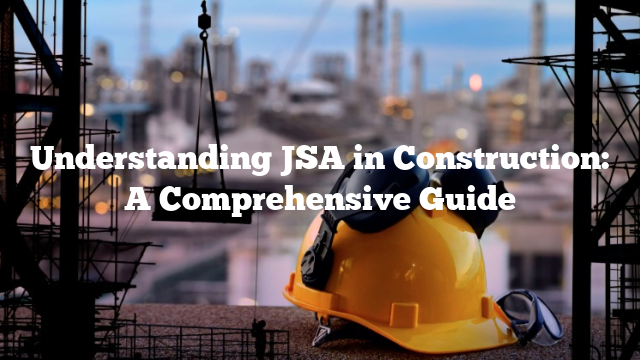“JSA in Construction: Everything You Need to Know”
Construction work is a high-risk job that requires thorough planning and execution to ensure the safety of workers and everyone involved. One of the essential tools used in the construction industry is the Job Safety Analysis (JSA), a process that identifies potential hazards and provides workers with the necessary information to mitigate risks. In this blog post, we will discuss what JSA in construction is, why it is important, and give you some tips and tutorials on how to create a comprehensive JSA plan for your construction site.
What is JSA in Construction?
JSA or Job Safety Analysis is a process that identifies potential hazards and risks associated with a particular task or job. It is a crucial component of an overall safety management system that helps prevent accidents and injuries in the workplace. JSA is also known as job hazard analysis (JHA) or task hazard analysis (THA), and it is required by the Occupational Safety and Health Administration (OSHA) for specific jobs and tasks.
Why is JSA Important in Construction?
Construction work is inherently dangerous, and workers are often exposed to various hazards such as falls, electrocution, and struck-by accidents. JSA plays a critical role in preventing accidents and injuries by identifying potential hazards and implementing safety measures to mitigate risks. By conducting a JSA, workers are equipped with the necessary information to perform their tasks safely, and employers can ensure that their workers are protected from harm.
Facts About JSA in Construction
– JSA is required by OSHA for specific jobs and tasks, including those that involve working at heights, heavy machinery, and hazardous materials.
– JSA involves a step-by-step analysis of a job or task to identify potential hazards and risks.
– JSA is a proactive approach to safety management that helps prevent accidents and injuries in the workplace.
– JSA should be reviewed and updated regularly to ensure that it remains relevant and effective.
A Listicle on How to Create a Comprehensive JSA Plan
1. Identify the job or task to be analyzed.
2. Break down the job or task into smaller steps.
3. Identify potential hazards and risks for each step.
4. Evaluate the severity and likelihood of each hazard.
5. Develop and implement safety measures to mitigate risks.
6. Train workers on the JSA plan and the safety measures in place.
7. Review and update the JSA plan regularly to ensure its effectiveness.
Tutorial of How to Conduct a JSA in Construction
1. Select a job or task to analyze.
2. Gather a team of workers familiar with the task.
3. Break down the job or task into smaller steps.
4. Identify potential hazards and risks for each step.
5. Evaluate the severity and likelihood of each hazard.
6. Develop and implement safety measures to mitigate risks.
7. Train workers on the JSA plan and the safety measures in place.
8. Review and update the JSA plan regularly to ensure its effectiveness.
Tips for Effective JSA in Construction
1. Involve workers in the JSA process to ensure their buy-in and participation.
2. Conduct regular safety training sessions to reinforce the importance of JSA and safety measures.
3. Use simple and clear language to communicate the JSA plan to workers.
4. Regularly review and update the JSA plan to ensure its effectiveness.
Question and Answer of What is JSA in Construction
Q: When is JSA required in construction?
A: JSA is required by OSHA for specific jobs and tasks, including those that involve working at heights, heavy machinery, and hazardous materials.
Q: How often should JSA be reviewed and updated?
A: JSA should be reviewed and updated regularly to ensure that it remains relevant and effective.
Q: Who should be involved in the JSA process?
A: Workers who are familiar with the job or task should be involved in the JSA process to ensure their buy-in and participation.
Q: What are the benefits of JSA in construction?
A: JSA helps prevent accidents and injuries in the workplace by identifying potential hazards and implementing safety measures to mitigate risks.
Conclusion of What is JSA in Construction
In conclusion, JSA is an essential tool in the construction industry that helps prevent accidents and injuries in the workplace. By identifying potential hazards and risks associated with a particular job or task, workers can perform their tasks safely, and employers can ensure that their workers are protected from harm. By following the tips and tutorials provided in this blog post, you can create a comprehensive JSA plan that will help keep your construction site safe and accident-free.
Recommendations:
- Safety Plan For Children Create a family safety plan. A toolkit for working with children and youth exposed to domestic violence the toolkit is to address this gap by providing support workers with a…
- Safety Plan Worksheet Pdf This safety plan comes with several phone numbers for suicide hotlines in the united states including one for the deaf and hard of hearing. Safety planning is one way to…
- Safety Inspection Report Template In line with this we have here safety report templates that you can download and use. Neglecting such reports could bring out legal and administrative consequences. Safety Report Templates 16…
- Job Risk Analysis Danger of injury is an inherent a part of most industries and initiatives. We can not eradicate threat entirely but we are able to cut back the chance and control…
- Job Safety Analysis Examples Risk of harm is an inherent a part of most industries and initiatives. We can't get rid of risk fully but we will cut back the risk and management it…
- Safety Planning Intervention Stanley Brown And c conducting role plays to practice implementing the. Stanley b brown gk a brief intervention to mitigate suicide risk. Safety Planning Intervention A Brief Intervention To Safety planning intervention…
- Construction Site Safety Inspection Checklist The standards referred to are south carolinas occupational safety and health standards for the construction industry as adopted from 29 cfr code of federal regulations part. Some construction companies will…
- Jsa Analysis Risk of damage is an inherent a part of most industries and projects. We can not eliminate danger fully however we are able to cut back the danger and management…
- Job Hazard Analysis Sample Risk of harm is an inherent a part of most industries and projects. We can not eradicate danger completely but we will cut back the risk and control it using…
- Safety Plan Worksheet Free Pdf The hazard analysis form should contain information to justify the identification of the hazards requiring preventive controls and the types of preventive controls applied. We therefore need to reduce pain…
- Safety Plan Worksheet Construction Important Remember to complete a thorough assessment of suicidality first. However it is a live and dynamic document that will change and grow during the project. Construction Safety Plan Template Pdf…
- Purpose Of Job Hazard Analysis Risk of damage is an inherent part of most industries and projects. We can't remove danger totally but we can scale back the risk and management it utilizing standard procedures…
- Job Hazard Examples Threat of damage is an inherent a part of most industries and projects. We can not get rid of risk entirely but we are able to cut back the chance…
- Job Site Analysis Form Threat of harm is an inherent part of most industries and projects. We cannot remove threat entirely but we can reduce the risk and management it using customary procedures and…
- Jsa Safety Risk of harm is an inherent a part of most industries and tasks. We can't eliminate risk fully but we will scale back the risk and control it using customary…
- Task Hazard Analysis Threat of injury is an inherent part of most industries and tasks. We can not remove threat solely however we will reduce the risk and management it using standard procedures…
- Hazard Analysis Form Danger of injury is an inherent part of most industries and initiatives. We can't remove risk solely but we can scale back the danger and control it utilizing commonplace procedures…
- Safety Plan Worksheet For Adults It is important that the safety plan worksheet is completed with the therapist and patient working together. 1 feeling safe being safe ety in an gency. Safety Plan Worksheet Therapist…
- Safety Planning A suicide safety plan is a written set of instructions that you create for yourself as a contingency plan should you begin to experience thoughts about harming yourselfit will contain…
- Safety Plan Worksheet Domestic Violence Related to domestic and other forms of family violence. Domestic violence advocate or friends name has agreed to help me review this plan. Domestic Violence Safety Plan Social Work Pinterest…
- Huge Safety Slogans Complete List Made Your Safety… Browse through the safety slogans in 2022 suggestions below. The safety slogans is one of Safety Communication method which successful of safety campaign was measured. So Safety Slogans is so…
- Printable Jsa Form Danger of damage is an inherent part of most industries and projects. We can not eradicate threat entirely however we are able to reduce the chance and control it utilizing…
- Safety Plan Worksheet No portion of the safety plan template may be reproduced. Displaying all worksheets related to safety plan. Safety Plan Worksheet Therapist Aid I can sometimes anticipate when i need to…
- Safety Plan Worksheet Sop Please note that this page has been updated for 2015 following a quality check and review of the templates and many new ones have been added. This page is a…
- Safety Planning Intervention Tool Brown university of pennsylvania school of medicine. Origin of safety planning intervention stanley brown20082012. A New Kind Of Safety Plan Social Work Tech The safety plan intervention is to include…
- Discover Job Hazard Analysis Examples to Improve… Job Hazard Analysis Examples. Every workplace has its own set of safety standards and procedures. But it can be difficult to know which safety protocols are most effective, and which…
- Printable Safety Plan Worksheet Domestic violence safety plan template is often used in safety plan template plan template and business. Some of the worksheets displayed are safety plan work safety plan work appendix food…
- Understanding the Importance of Job Safety Analysis… Painting can be a tedious and dangerous task, especially when it comes to large-scale projects. Workers need to be aware of the potential hazards involved in the process and take…
- The Importance of Job Safety Analysis for Loading… Job Safety Analysis for Loading and Unloading: Keeping Workers Safe As businesses continue to grow, loading and unloading activities have become more common. While these activities are necessary for the…
- Task Hazard Analysis Form Risk of injury is an inherent part of most industries and tasks. We can't remove risk completely however we will cut back the risk and control it utilizing standard procedures…
Advertisement
Scroll to Continue With Content



